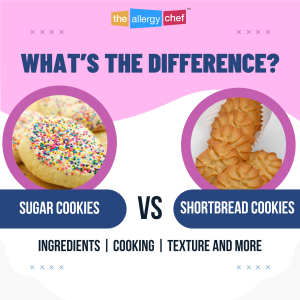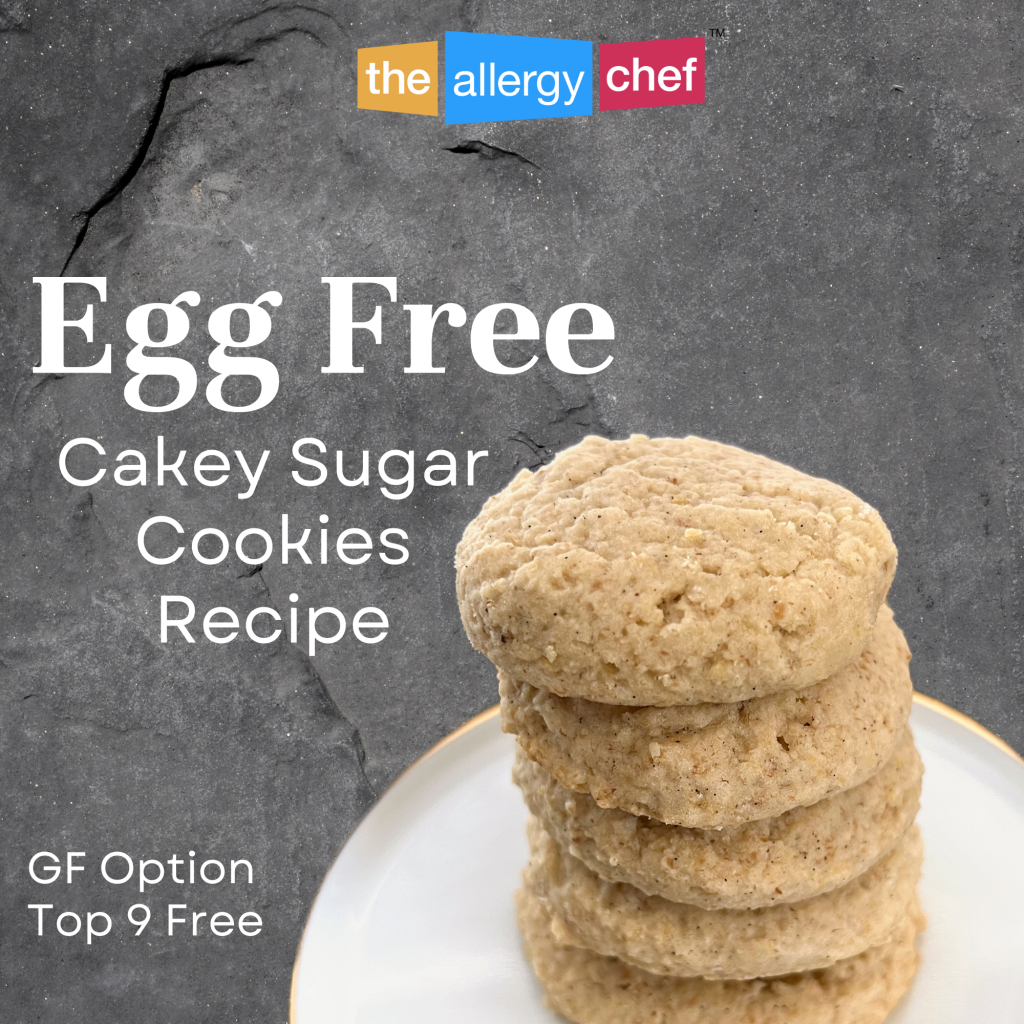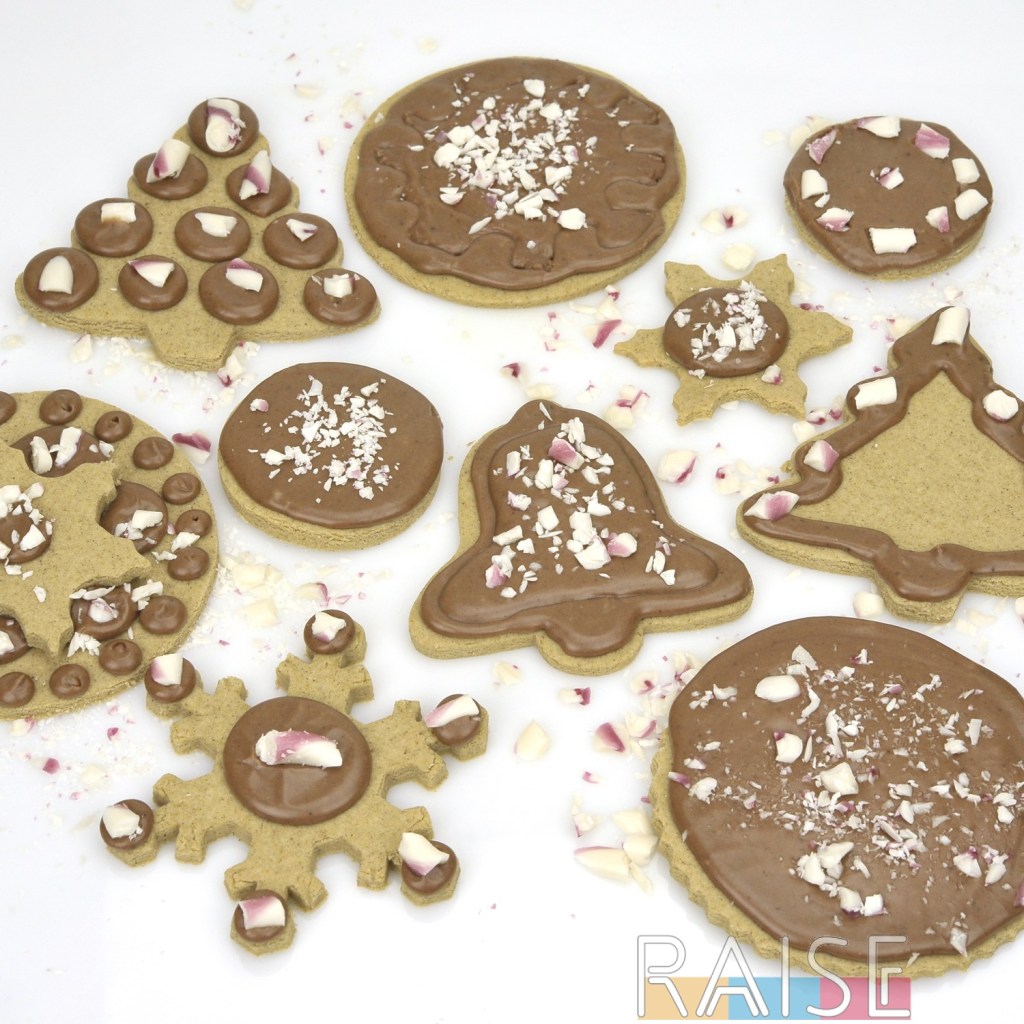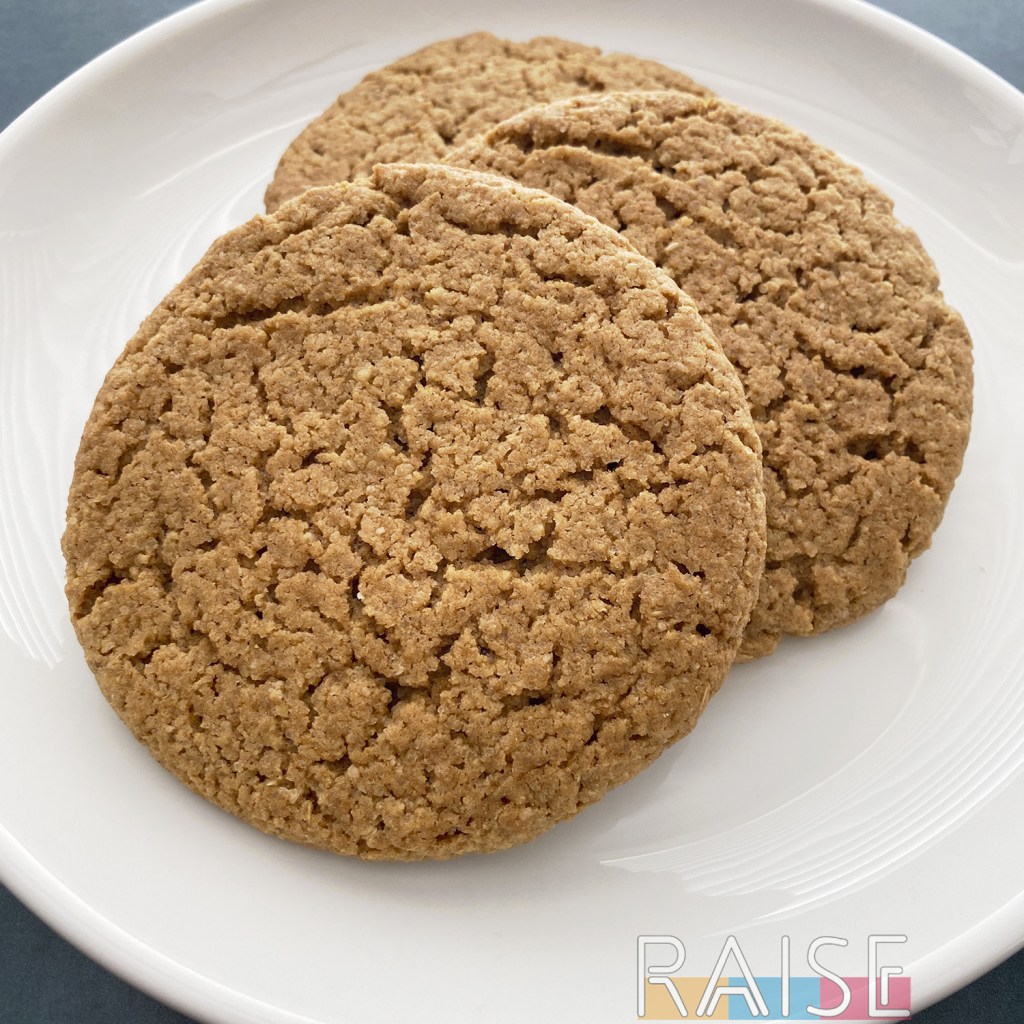If you’re gearing up to do a lot of baking, you may be wondering what’s the difference between shortbread cookies and sugar cookies. Today, we’re going to take a look at how the same basic ingredients can produce wildly different results, yet two different delicious cookies.
Shortbread cookies are a crisp, and rich type of cookie with a crumbly texture. They have a long history in the culinary world and are loved internationally. Sugar cookies have a soft texture, and a melt in your mouth type of feel. Some people choose to follow a sugar cookie recipe that produces a more chewy texture, which is closer to what you’d find in a chocolate chip cookie recipe.
Both cookies are incredibly popular and are especially enjoyed during special occasions and Christmas time. Many people enjoy gifting cookies to friends and family during the holiday season, and will include shortbread cookies and/or sugar cookies in their gift boxes.
Cookies, if you ask me, are the perfect canvas for those who love to decorate. Both doughs can be rolled out and formed into different shapes using cookie cutters. You can also use royal icing, buttercream frosting on both cookies once they’ve cooled.
Similarities Between Sugar Cookies and Shortbread Cookies
Both sugar cookies and shortbread cookies use the same three main ingredients of butter, sugar, and flour. The ratios are a bit different, and sugar cookies have extra ingredients.
Both are baked cookies that use the same types of tools to make: stand mixer with paddle attachment, rolling pin, wire rack for cooling, and so on.
Both are baked on a cookie sheet/baking pan in the oven. Personally, I use parchment paper for baking rather than a cooking spray or a prepared baking sheet with flour.
When comparing a basic sugar cookie recipe and shortbread recipe, they both use a chemical leavening agent.
Baking temperature: if you look up a classic recipe for both sugar cookies and shortbread cookies, the baking temperature is usually 350 degrees f (175c). Interestingly, you can use a lower temperature of 325f/160c, which is something I do often.
Both sugar cookies and shortbread cookies can be made with additional flavouring agents such as zest, herbs, and extracts. However, this is more common with shortbread cookie recipes.
Both cookies can be made gluten free, refined sugar free, dairy free, egg free, and more.
When making free-from cookies, both can be frozen and thawed in both their dough form and final baked form. I can’t vouch for the freezing quality of cookies containing gluten, egg, milk, etc., since I don’t bake with those ingredients, but I know many can be frozen.
Key Differences Between Sugar Cookies and Shortbread Cookies
The amount of flour in the recipe’s ratio of ingredients (sugar cookie dough has a bit more flour than shortbread cookie dough).
You can have soft sugar cookies or crisp sugar cookies, but shortbread cookies are usually crisp. Most come out of the oven a bit soft, but firm up as they cool.
The unbaked dough tastes different when compared side by side, but the textures of the unbaked dough is pretty similar.
Sugar content: not only do the cookies have a different sugar to butter ratio, but shortbread dough typically uses powdered sugar instead of granulated cane sugar.
A typical sugar cookie recipe contains egg where its shortbread counterparts do not contain eggs.
Usually, classic shortbread cookies are rolled out, or you use a cookie gun to get the dough on to the tray. Most cookie guns have a design and the cookie holds said design. Sugar cookies can be rolled out, however, they can also be made as drop cookies. That’s where you place a scoop of the dough on your tray and bake.
Many sugar cookies are topped with sugar crystals or sprinkles. They’re also often frosted.
Typical Ingredients In a Sugar Cookie Recipe
- All Purpose Flour
- Unsalted Butter
- Granulated White Cane Sugar
- Whole Egg
- Baking Powder
- Salt
- Vanilla Extract
Typical Ingredients in a Shortbread Cookie Recipe
- All Purpose Flour
- Unsalted Butter
- Powdered Sugar
- Baking Powder
- Salt
- Flavouring Agent (vanilla, rosemary, lavender, orange, almond extract, etc.)
Tips on Perfecting the Classic Cookie
Start with good quality butter. Your cookies are only as good as the raw materials. I generally only bake with organic and all natural ingredients. People are always BLOWN away by how much better my baked goods taste when compared to what they normally have.
Use the right tools. Many cookie recipes do best when whipped at high speeds, which is something most people can’t do by hand. If you’re not ready to invest in a stand mixer, make sure you have a good hand held electric mixer to get the job done. If you plan on baking a lot of cookies or starting a small bakery, I can’t suggest enough investing in a large commercial 8 quart Kitchen Aide stand mixer. It’s what I have and I have zero regrets.
Make sure you have a good baking tray and room on said tray. Crowding cookies on your tray usually leads to poorly baked cookies.
Know your oven! It’s so important that you test your oven’s actual temperature with an oven thermometer (not the same as other types). In one kitchen I had, there was a double oven and the two ovens were not the same temperature. I always thought the bottom oven ran hot. I got an oven thermometer and turns out the top oven (with a digital temperature control) ran 25 degrees under what it said and the bottom oven (with a manual knob) was the correct temperature. In addition to that, you need to map your oven with a tray of flour or a tray of bread. See how the colour develops, and note if there are any hot spots in the oven. If you want produce perfect sugar cookies or perfect shortbread cookies, you need to make sure the temperature is spot on.
Figure out what you like! Sure, we can all talk about a classic sugar cookie or a classic shortbread cookie. However, if you don’t like the taste or texture of a classic cookie everyone is raving about, tweak the recipe until you’re happy with it. Perhaps it needs more vanilla, or you don’t like the almond extract many recipes call for. At the end the end of the day, the best cookies are cookies that you love.
Ways to Experiment at Home
If you’re a science nerd like I am, you can take your simple ingredients and shake them up a bit for some fun experimenting. For example, purchase caster sugar (a superfine sugar) and use that in place of the cane sugar in sugar cookies or the powdered sugar in shortbread cookies. See what you think about the results.
Skip the chilling step. Cookies will behave differently when they’re baked from chilled rather than from room temperature. See how your recipe performs at different temperatures.
Try your hand at making brown butter, then using that in your cookie recipe. Brown butter has a nuttier, deeper, richer flavour when compared to regular butter. Be sure to follow a recipe that specifically uses brown butter so you know the necessary steps to properly shaping your cookie dough.
Try making a lemon shortbread cookie recipe with lemon zest or a pistachio shortbread cookie recipe. Small changes like these can make a great addition to your cookies, and you may find a new family favourite.
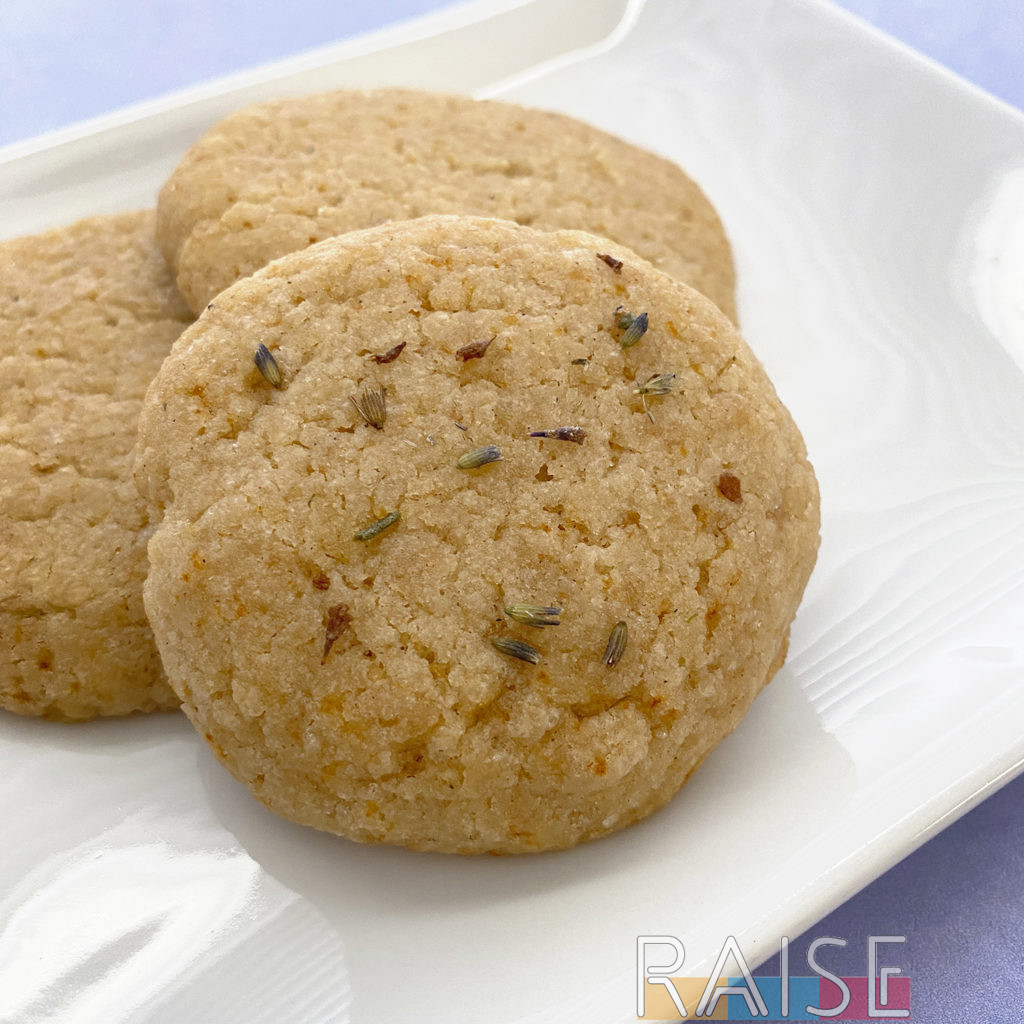
Honey Lavender Cookies
Answering Your Sugar Cookie and Shortbread Cookie Questions
Do I have to use a lightly floured surface when rolling out cookie dough?
For best results, you’ll want to prevent the dough from sticking to the work surface. There are different ways to do this, and many bakers like using a bit of flour on their work surface. My personal preference is to work on a large piece of parchment paper. I roll it out, put the dough on it, then place another large piece of parchment paper on top. It keeps the rolling pin and the work surface clean. Once I have the cookie dough to the size I want it to be, I move on to the next steps.
Can I add chocolate chips to my shortbread cookie recipe?
Whilst traditional shortbread cookies don’t contain chocolate chips, yes, you can add them to the dough before baking. I’d suggest using mini chocolate chips since most shortbread cookies are rolled to a pretty thin height. Regular chocolate chips might stick out a bit. In terms of taste, it will be different, but I think you’ll enjoy it. You could always start by adding chocolate chips to a small amount of cookies before baking to make sure you enjoy the new taste and texture. Honestly, chocolate chip shortbread cookies sound awesome to me, so I hope you give it a go and enjoy them.
Can I use icing sugar on both sugar cookies and shortbread cookies?
Yes, you can. Icing sugar is another name for powdered sugar, sometimes called confectioners’ sugar. Recipes for frosting and glazes will contain powdered sugar, and these glazes can be used on both sugar cookies and shortbread cookies. If you plan on decorating sugar cookies, make sure they’re in a shape that will hold the icing well (think domed cookie vs flat cookie).
When making cookies, should I use salted butter or unsalted butter?
Unless the recipe developer calls for something specific, I’d suggest sticking with unsalted butter. Most cookie recipes call for salt and when you combine salted butter with extra salt, it can throw off the final flavour of the baked cookies. When in doubt, you can also reach out to the recipe developer to find out what they used. I know for all of my recipes, I only use unsalted butter.
Is a shortbread cookie the same thing as a traditional Scottish shortbread cookie?
Scottish shortbread cookies are not the same thing as a shortbread cookie. In fact, some Scotts don’t call their shortbread cookies. Scottish shortbread is usually made from four very simple ingredients: flour, butter, sugar, and salt. One could argue these could be called brown sugar shortbread cookies since many recipes call for brown sugar. Scottish shortbread cookies lack any type of leavening agent, are usually not decorated with a frosting/icing, and are commonly paired with drinks.
I can tell you this: two of my kids LOVE Scottish shortbread cookies (their grandmother is from Scotland) and they can absolutely tell the difference between the two types of cookies.
Are shortbread cookies the same thing as butter cookies?
No, they aren’t the same. Some of the ingredients overlap, but shortbread cookies are a simple recipe when compared to a traditional butter cookie recipe. Butter cookies use a different type of sugar and usually contain egg yolk, more flour, and some kind of flavouring agent (such as orange or lemon). Either would be an excellent choice to make, even if your goal is to use cookie cutters. Both doughs hold up well when rolled out and shaped.
Do I need to use plastic wrap when chilling my dough?
It’s strongly recommended as it will help prevent your dough from drying out. Plastic wrap/cling wrap forms a great barrier from the air in your fridge. If you’re all out, you can use a freezer bag. Be sure to press out all of the excess air before sealing it up.
Can royal icing be used on sugar cookies?
Yes, all decorative frostings and icings can be used on sugar cookies. I suggest making sure you have the proper tools for decorating and that the cookies be the right shape to hold your icing (so it doesn’t drip/run off the sides).
Can I use brown sugar when making shortbread cookies?
Yes, you can, however, know that this will change the overall texture and flavour of your sweet treat. It won’t be bad, and your cookies won’t be ruined, they’ll just be different. Who knows, you may love the change. When I make shortbread cookies, I actually use organic maple sugar in place of the powdered sugar, so I can confirm that a granulated sweetener will indeed work out just fine.
Can I swap the sugar in my sugar cookie recipe for powdered sugar?
Powdered sugar, sometimes called icing sugar, will not produce a classic sugar cookie. If you’re aiming for classic, you’ll want to stick to white cane sugar. If you’re all out, you could use light brown sugar, but again, it won’t be a classic sugar cookie anymore.
Is there a way to make powdered sugar at home?
Yes. The general base recipe for homemade powdered sugar is 2 cups of cane sugar + 2 Tablespoons of corn starch. You blend that up on high speed in your blender. However, that recipe is flexible. For example, you can swap the corn starch for arrowroot which is something I do since I have a severe corn allergy and corn products aren’t in my home. You can also make powdered sugar from date sugar, coconut sugar, maple sugar, and any other dry granulated sugar.
Light brown sugar and dark brown sugar aren’t the best candidates for making powdered sugar at home since they have a higher moisture content. However, if you have an older bag of one of these and the sugar has gone hard and dry, you could transform that into powdered sugar.

